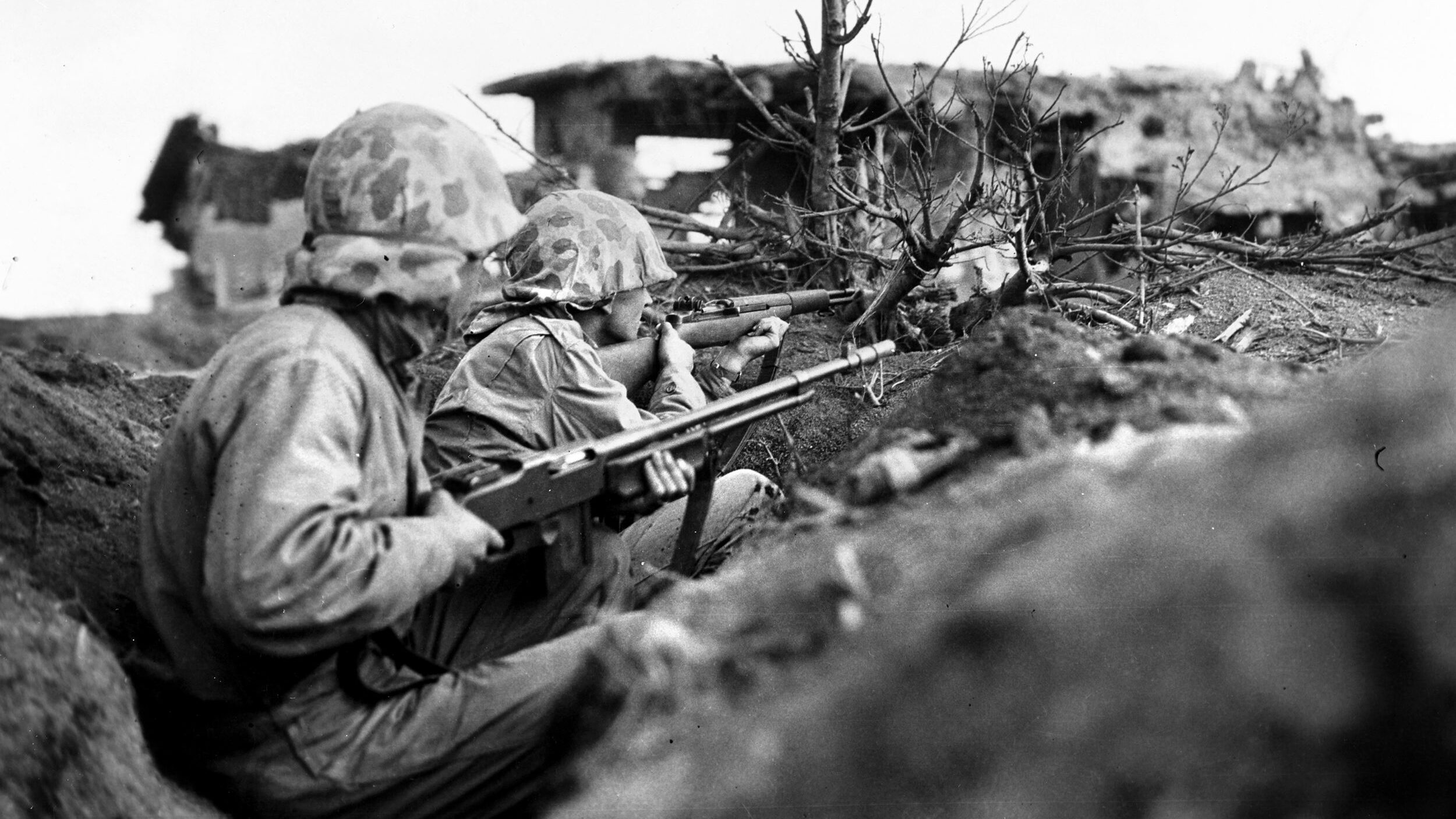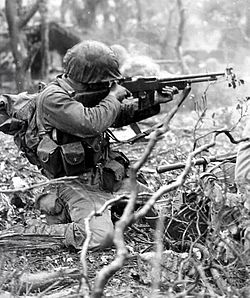Let’s discuss the Browning Automatic Rifle, the mighty BAR. The gun that showed up to war, kicked the damn door in, lit a cigar, and told the rest of the squad, “Follow me, boys, I’ll lead you to Berlin.”
Invented by the patron saint of American firearms, John Moses Browning, the BAR (specifically the M1918) was designed at the tail end of World War I. The goal? Give doughboys something man-portable that could spit .30-06 hate downrange while maneuvering, a “walking fire” concept that turned trench warfare on its head. And even though WWI ended before the BAR could really flex, it was just getting warmed up.
Forged For War: The Birth of the BAR
The year? 1917, and America had just been dragged into the meat grinder that was World War I. While the Europeans were struggling with bolt-action rifles and artillery that was closer to a catapult in functionality, the U.S. Army wanted something different. Something that could move and shoot in the horror and chaos of trench warfare.
Enter John Moses Browning, the Leonardo da Vinci of weapons design, except for instead of the Mona Lisa, he built things that could put holes in fascists from 600 yards. Within three months of getting the Army’s request for a man-portable automatic rifle, Browning delivered the prototype that would eventually become the M1918 BAR. For the record, 90 days is about the time it takes our modern defense leaders to decide on their latest death by PowerPoint presentation.
The BAR was tested at the Springfield Armory and was immediately adopted after outperforming the French Chauchat (which was a jam-prone cheese grater with a trigger.) The Army placed an initial order for 12,000 rifles, and by the time the war ended, 102,125 BAR’s had been produced, though many wouldn’t see action until WWII.

A Design Straight From Valhalla
Let’s talk specs. The BAR was no dinky pea-shooter. It chambered the mighty .30-06 Springfield, the same round used in the M1 Garand, but with a 20-round box mag and full-auto capability. We’re talking 550 rounds per minute of America-first freedom.
Weighing in at 16 pounds unloaded, it was no ballerina, but the heft helped soak up recoil and reminded you that you were carrying a damn machine gun, not a glorified carbine. It had a gas-operated, long-stroke piston system that was reliable, robust, and resistant to battlefield crud. The BAR thrived in battlefield conditions that turned lesser weapons into paperweights. Every inch of it screamed “I’m here to kill Nazis, not win design awards.”
The later M1918A2 variant added a bipod, shoulder support plate, and select-fire modes (slow auto vs fast auto, still no semi) making it more versatile and deadly. If the enemy was intelligent, they ran. If they weren’t, they learned their lesson in blood.

World War II: The BAR Earns Its Stripes
By WWII, the BAR had found its calling. Issued to 12-man infantry squads as their base of fire, it was wielded by the Automatic Rifleman, a position that meant you were expected to lay hate, take point, and quite possibly be the first one shot at. Your buddies generally carried the rest of your mags, that’s how vital it was. The job of the BAR man wasn’t easy. You were heavier, slower, and targeted. However, you also carried the hammer that could turn the tide of a firefight. Veterans often described a strange comfort in hearing the BAR open up behind them, because it meant that the fight might be about to turn in their favor. Make no mistake, when the BAR sang, it sang in .30-06 gospel.
The BAR always delivered. From Normandy, Hurtgen Forest, Anzio, and Bastogne, BAR gunners laid waste to German positions, giving American squads suppressive firepower that could shift momentum, pin down enemy machine gunners, and punch through thick brush like it owed Browning money.
The Korean War: Cold Steel in Cold Hell
If the BAR proved itself in WWII, it ascended to myth in Korea. Against massed Chinese human wave attacks, American forces had to rely on sheer firepower to hold their lines, and the BAR was right there, chugging through the freezing dark like a metal heartbeat.
Reports from the Battle of Chosin Reservoir describe BAR gunners dumping mag after mag into advancing enemies, the snow around them blackened with cordite and blood. The cold seized up rifles, froze machine gun barrels, and cracked lubricants, but by many accounts, the BAR kept…on…running. It wasn’t flawless, but you could depend on it, and in -30F temperatures, that was everything.
The Army fielded M1918A2’s with bipods and shoulder plates, but many gunners ended up tossing these extras to save weight and improve maneuvers. Korea was no trench war, it was fought over ridgelines, ambushes, and sudden overwhelming charges. The BAR adapted and delivered, proving again that it was not just the old war dog, but a guardian angel to troops far away from home.
Vietnam: The Last Stand of the BAR
By the time American boots hit Vietnamese soil, the BAR was on its way out, officially. Unofficially though, it was still slinging .30-06 goodness. Some U.S. Advisors, ARVN troops, and local militas clung to the BAR like a relic of better firepower, and for good reason. The M16 was teething, still finding its footing and working out design flaws. The M60, though incredibly potent, was bulky and jam-prone in its first iterations (speaking of, you can find my write up on the pig here.)
The BAR just worked. In the thick jungles of the Mekong, or the highlands near Da Nang, a reliable, hard-hitting automatic rifle was worth its weight in gold. Some Veterans described encounters where old beat-to-hell BARs, dating all the way back to WWII were still humming like angry typewriters, cutting through vegetation and VC ambushes with ease. It wasn’t the future, but it damn sure reminded the enemy of the past.

Real World Tales: When the BAR Did the Talking
BASTOGNE, 1944:
In the frozen seige of Bastogne, PFC. John McAuliffe of the 101st Airborne held a road junction alone with his BAR for over an hour under heavy German fire. He went through six magazines, jammed once after falling into a crater, cleared it with a stick, and kept fighting.
His after-action report simply stated: “The BAR barked. Jerry shut up. I lived.”
HILL 902, KOREA:
Corporal Hector Caffey, manning a BAR, held Hill 902 against two full Chinese charges. When the barrel overheated, this he-man whipped out his junk, and urinated on it to cool it off. Reinforcements found him hours later, eyes wild, gloves melted from the heat, and one magazine left.
“Didn’t have time to be scared. Had a BAR. Figured if I was going out, I’d take a few hundred of them with me.”
SAINT-LO, 1944:
Staff Sergeant Roy Allen used his BAR to fire through a stone wall where German snipers had been firing from. The penetration of .30-06 was so effective it knocked out the threat without needing grenades or backup.
“The BAR was our battering ram. We didn’t kick in doors, we leveled the damn wall first.”

Field Loadout: What a BAR Gunner Really Carried
Primary Weapon
- M1918A2 BAR – 16 lbs unloaded
- Rate of Fire: 500-650 rounds per minute
- .30-06 Springfield
Ammo Loadout
- 12-16 steel mags, 20 rounds each
- Total: 240-320 rounds
- Worn in M1937 BAR belt, bandoliers, or stuffed anywhere you could fit them
- Squadmates carried backup mags, everyone fed the beast
Gear and Accessories
- Bipod (optional)
- Asbestos gloves (no OSHA back then)
- Basic Cleaning Kit
- Canvas Sling
- Optional: Spare bolt, magazine loader, sight covers
Other Gear
- Entrenching tool, field rations, helmet, fighting knife. Sidearms were rare
- Heavy wool uniform soaked in sweat and destiny.
Final Shot: A Thunder Still Echoes
The BAR was a heavy weapon, that was clunky and had a small magazine. It wasn’t particularly pretty, and it lacked semi-auto fire. Despite those flaws, it stood tall as one of the most dependable, feared, and respected weapons in American military history. The BAR was battlefield attitude. Loud, unyielding, and built for the long haul, from WWI trenches to the rice fields of Vietnam, the BAR proved that simple, brutal efficiency can win wars.
Though it’s no longer issued, every time a modern DMR or SAW lays down fire for a squad, they owe a nod to the beast that came before. The BAR may be in museums now, but its legacy beats hot-blooded, round by round, mag by mag, freedom through fire.
Read the full article here


